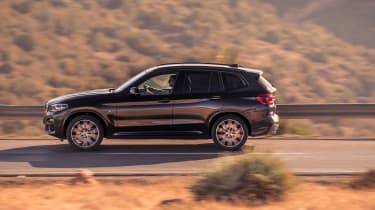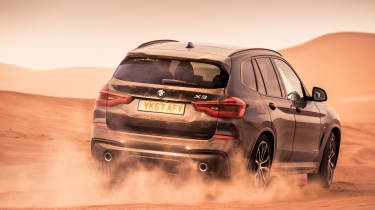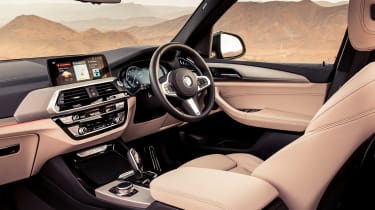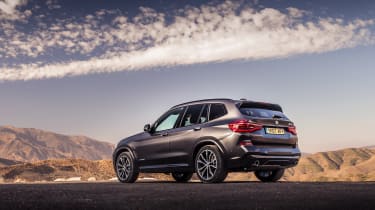New BMW X3 diesel review - 20d and 30d SUV duo driven
BMW’s latest SUV should sell better than ever, but entertainment takes a back seat to practicality and tech
We’ve already driven the performance variant of the new BMW X3, the M40i, but this is our first opportunity to get behind the wheel of the models that most customers will end up buying - the X3 20d and X3 30d.
With underpinnings, powerplants and features cribbed from the current 5-series, BMW says the new X3 builds on the old car’s dynamics and improves on its technology and connectivity. We were quietly impressed by these advancements in the X3 M40i - so how to the regular models fare?
Engine, transmission and 0-60mph time
As implied by their model designations, the X3 20d uses BMW’s 2-litre turbocharged four-cylinder diesel engine, while the X3 30d packs a 3-litre inline-six turbodiesel. The former develops 187bhp with 295lb ft of torque available, overcoming a 1750kg kerb weight to post a 0-62mph of eight seconds flat.
The 30d is, not unsurprisingly, a fair bit quicker. Maximum power here is 261bhp, and it develops half as much torque again as the 20d at 457lb ft. There’s more weight to lug around - 70kg more, in fact - but the 30d still manages to reach 60mph in 5.8 seconds from rest and go on to 149mph. For comparison, the X3 M40i is a second quicker to 62mph and hits its limiter 6mph later.
More reviews
Reviews
- BMW X3 M50 2025 review – 393bhp six-cylinder SUV previews the X3 M
- BMW X3 M Competition 2022 review
- BMW X3 M40d 2022 review – a compelling alternative to an Audi SQ5?
- BMW X3 M40i review – BMW’s latest performance SUV
- BMW X3 review - strong engines help make this an impressive SUV
- BMW X3 review - strong engines help make this an impressive SUV
> Click here to read our review of the BMW X3 M40i
No manual transmission is offered - customers of the previous generation rarely ticked that box, according to BMW - so an eight-speed ZF-developed Steptronic automatic transmission is the only one available. There are no two-wheel drive models this time around either - all-wheel drive is standard.
Technical highlights
BMW claims the X3 is the most aerodynamically-efficient car in its class, with a drag coefficient of 0.29. Still some way behind conventional, non-SUV cars - the 5-series on which the X3 is based dips as low as 0.22, and has a smaller frontal area too. While that might have compromised refinement next to a 5-series, the new X3 has been filled with extra cladding and, for £120, acoustic glazing, which cuts noise to minimal levels.
Wheels start an inch bigger than before - from 18 inches - and M Sport models come as standard with upgraded brakes with four-piston calipers up front. These are available as an option elsewhere, as is the M Sport’s uprated suspension. Variable Damper Control is also an option, along with features like the 5/7-series style “Display Key” and upgrades to connectivity, including gesture control. Some semi-autonomous features are available under the guise of BMW Personal CoPilot.
What’s it like to drive?
We drove both engines in M Sport specification (with its upgraded suspension and brakes), a trim level that the majority of UK customers will opt for when the time comes to sign on the dotted line.
Visually this adds a dash of aggression to the X3’s shape, but unless you’re already familiar with the previous car you’ll probably struggle to distinguish this one as an all-new model. A little softer in its details, a little larger in its kidney grille, but still identifiably an X3. It looks surprisingly compact from the outside but feels substantial when inside.
The interior takes a big step up from before, looking and feeling much like that of the current 5-series. That’s a good thing, in case you were wondering, with a logic to the layout, a quality feel to every surface and a sense of solidity - spoiled slightly in one of our test cars by a buzz coming from within a passenger doorcard. The new seats are adjustable every which way and very comfortable, the visibility is on-par with others in the class, and both the rear cabin and boot are spacious and well-shaped.
Things don’t deteriorate once you get underway. The ride can feel firm over certain surfaces but otherwise shrugs off most imperfections (helped by a stiff structure and those comfortable seats), and the steering feels precise with predictable movements of the nose as soon as you begin to turn into a corner. Feedback? Not really, and the M Sport cars’ needlessly thick steering wheel rim doesn’t help, but combined with good grip (and strong, well-modulated brakes), this is a car whose responses you can trust.
Both engines feel punchy too, the 20d almost to the point where you wouldn't feel too short-changed if you also got to try the 30d. The 2-litre is brisk enough for most driving conditions and BMW’s efforts to hush the cabin mean even under hard acceleration it remains admirably muted. Gearshifts, as we’ve come to expect from this ZF ‘box, are slick and responsive whether left to their own devices or activated with the paddles on the back of the steering wheel.
The six-pot is undoubtedly more pleasurable to drive - it picks up sooner, moves with more conviction under every throttle input, and sounds creamy smooth even at higher revs. But in the X3 you’re less inclined to utilise the performance than you are in a 3-series or 5-series, and the X3 M40i delivers more vividly on the entertainment front, so if you’re going diesel you might as well opt for the more frugal of the pair. Dull perhaps, but true.
Price and rivals
And that rather sums up the X3 experience, at least with the diesel powertrains. Despite the X3’s competent chassis, it’s not a car you’re likely to use out of anything other than utility - and in that scenario, we’d still rather opt for BMW’s own outstandingly well-rounded 5-series Touring. It’s more attractive, more dynamically capable, and available for similar money - £38,835 for a 520d xDrive SE, compared to £38,880 for an equivalent X3.
For the time being, that’s the entry point into X3 ownership, with M Sport models starting at £41,380 and the 30d in SE trim beginning at £44,380. Those numbers are a tad more than a Mercedes-Benz GLC - £36,380 in 220d SE trim, £42,185 for the six-cylinder 350d SE - but less than a Porsche Macan S Diesel (competitor for the 30d), which is £45,942.
The X3 is probably the most practical option of that selection, though we’d opt for the Porsche if we wanted a little more fun - though we’d still have an eye on that 5-series Touring.
> Read our BMW 5-series Touring review here








